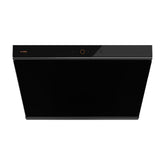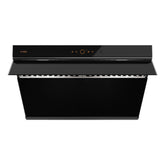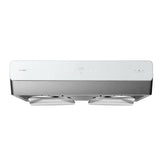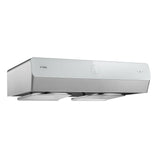What Is an Induction Range? Benefits & How It Works
Last Updated: 7/17/2025
Author: James Zhao, Sr. Tech Specialist & Alex Park, Product Specialist
Sick of waiting forever for water to boil? Tired of cooktops that take too long to respond, or worse, stay hot long after you’re done cooking? If you’re ready for a smarter, faster, and safer way to cook, an induction range may be right for you.
So, what is an induction range? Unlike traditional gas or electric ranges, induction ranges use electromagnetic energy to heat your cookware directly, not the cooktop surface. This means fast heating, precise temperature control, and a cooktop that stays cool to the touch, even during use. In this guide, we’ll break down how induction cooking works, its key benefits, and how it compares to gas and electric ranges.
FOTILE’s innovative induction cooktops make cooking more enjoyable and kitchen cleanups a breeze. With ultra-quick heating, sleek black ceramic glass, and responsive touch controls, you’ll look forward to cooking every meal. Shop our induction cooktops to find the perfect fit for your kitchen.
Induction Ranges Explained
Induction ranges may look similar to electric cooktops, but they’re powered by a completely different technology. If you’ve ever wished your stove would heat faster, clean easier, and feel safer for your kids, induction may be exactly what you’ve been looking for.
How Do Induction Ranges Work?
Induction ranges run on electromagnetic fields that generate heat inside your cookware, rather than underneath it. Here's how it works:
- Direct-to-pan heat: When a magnetic-base pot or pan is placed on the induction cooktop, a magnetic field interacts with the metal, producing resistance and generating heat directly within the cookware itself. No flame. No red-hot coils.
- Cool-to-touch surface: Since the cooktop doesn’t get hot (only the cookware does), the surface stays much cooler than gas or electric options. This means less risk of burns and easier cleanup.
To cook on an induction range, you’ll need pots and pans with a magnetic bottom. Cast iron and most stainless steel pans will work. To check whether your pan is compatible, stick a magnet to its bottom. If it sticks, it can be used on an induction range!
Benefits of Induction Ranges
Switching to an induction range can transform your entire cooking experience. From faster meals to safer surfaces and lower energy bills, here’s what makes induction worth considering:
Cooking Speed & Efficiency
Induction ranges heat cookware almost instantly, making them faster than gas or electric ranges. No wasted time heating burners or the air around the pot; just direct, immediate heat transfer that gets dinner on the table faster.
Heating Precision & Control
Induction lets you dial in the exact temperature you need, instantly. Whether you’re melting chocolate or getting the perfect sear on a steak, the heat responds immediately to your adjustments.
Energy Efficiency
Since induction transfers energy directly to the cookware with minimal heat loss, it’s one of the most energy-efficient cooking technologies on the market. Your kitchen stays cooler, and your electricity bill may even get lower over time.
Safety Features
With no open flames or red-hot coils, induction cooking is a much safer option, especially if you have kids. The surface stays relatively cool to the touch, and built-in features like residual heat indicators let you know when it’s still warm. Plus, the cooktop won’t activate unless compatible cookware is placed on it.
Seamless Maintenance
Spilled sauce? Boiled-over pasta water? No problem. The smooth ceramic glass surface of an induction cooktop is easy to wipe clean and doesn’t get hot enough to burn on messes.
Induction vs. Gas vs. Electric Ranges: Key Differences
Here’s how induction compares to traditional gas and electric ranges:
| Feature | Induction Range | Gas Range | Electric Range |
|---|---|---|---|
| Heating Method | Electromagnetic energy heats the cookware directly | Open flame heats the bottom of the pan | Electric coils or radiant elements heat the cooktop surface |
| Heating Speed | Fastest: instant heat transfer to the pan | Moderate: quick flame but less efficient heat transfer | Slower: coils take time to heat up and cool down |
| Energy Efficiency | Most efficient with minimal heat loss | Least efficient; heat escapes into the air | Fair; better than gas, but not as efficient as induction |
| Cooktop Surface | Smooth glass stays cool except under cookware | Grates and burners stay hot after cooking | Coil or glass stays hot long after use |
| Safety | Safe: no flame, cool surface, auto shut-off | Open flame; risk of burns, fire, or gas leaks | Hot coils/glass; risk of burns even after cooking |
| Cleaning | Easy; smooth, wipeable surface | Harder; food can get stuck in grates or burners | Moderate; smooth top is easier, coils are harder to clean |
| Cookware Required | Needs magnetic-base cookware | Any cookware | Any cookware |
Is an Induction Range Right for You? What To Consider
Before making the switch to an induction range, consider the following:
- Budget: While induction ranges often cost more initially, they offer long-term savings through faster cooking and lower energy usage.
- Electrical setup: Does your kitchen have the proper 240V outlet? You may need to upgrade your wiring if you’re switching from gas.
- Cooking preferences: If you love cooking over an open flame or often use specialty cookware (like woks), gas may be more ideal. However, if you prefer precision, safety, and speed, induction is hard to beat.
- Design priorities: Do you want a sleek, modern cooktop that wipes clean in seconds? Induction offers a streamlined look with easy maintenance.
Change The Way You Cook with FOTILE Induction Cooktops
FOTILE induction cooktops combine cutting-edge technology, elegant design, and effortless control to transform the way you cook. With lightning-fast heating, precise temperature control, and easy-to-clean surfaces, every detail is designed with the modern home chef in mind.
Ready to experience the future of cooking? Shop our induction cooktops and find the perfect fit for your kitchen today.
- Choosing a selection results in a full page refresh.






